Invented by Mads Hald Andersen, Per Thor Straten, IO Biotech ApS
Immunotherapy has emerged as a revolutionary approach in cancer treatment, harnessing the power of the immune system to target and destroy cancer cells. While traditional treatments like chemotherapy and radiation therapy can be effective, they often come with severe side effects and limited efficacy. IDO-based immunotherapy offers a new avenue for cancer treatment, with the potential to enhance the body’s natural defenses against cancer cells.
The market for IDO-based immunotherapy is driven by the increasing prevalence of cancer worldwide. According to the World Health Organization (WHO), cancer is one of the leading causes of death globally, with approximately 10 million deaths reported in 2020 alone. This rising burden of cancer has spurred significant investments in research and development of novel therapies, including IDO-based immunotherapy.
Several pharmaceutical companies are actively involved in the development of IDO inhibitors, which are designed to block the activity of the IDO enzyme. By inhibiting IDO, these drugs aim to prevent the immune system from being suppressed by cancer cells, allowing it to mount a more robust response against the tumor. Some of the leading players in this market include NewLink Genetics, Bristol-Myers Squibb, and Incyte Corporation.
Clinical trials evaluating the efficacy and safety of IDO inhibitors have shown promising results. For example, Epacadostat, an IDO inhibitor developed by Incyte Corporation, demonstrated positive outcomes in combination with other immunotherapies in patients with advanced melanoma. These encouraging results have fueled the interest and investment in IDO-based immunotherapy.
The market for IDO-based immunotherapy is not limited to cancer treatment alone. IDO inhibitors have also shown potential in treating other diseases, such as autoimmune disorders and infectious diseases. By modulating the immune response, IDO-based therapies have the potential to address a wide range of conditions where immune dysregulation plays a role.
However, challenges remain in the development and commercialization of IDO-based immunotherapy. One of the main hurdles is identifying the right patient population that would benefit the most from this treatment. Biomarkers and predictive tests are being developed to help identify patients who are most likely to respond to IDO inhibitors, enabling personalized treatment approaches.
Another challenge is the potential for resistance to IDO inhibitors. Cancer cells can develop mechanisms to evade the immune system, including alternative pathways to suppress immune responses. Ongoing research aims to understand these resistance mechanisms and develop combination therapies that can overcome them.
Despite these challenges, the market for IDO-based immunotherapy holds immense potential. With the increasing understanding of the immune system and advancements in drug development, IDO inhibitors have the potential to revolutionize cancer treatment and improve patient outcomes. As more clinical trials are conducted and regulatory approvals are obtained, the market for IDO-based immunotherapy is expected to grow significantly in the coming years.
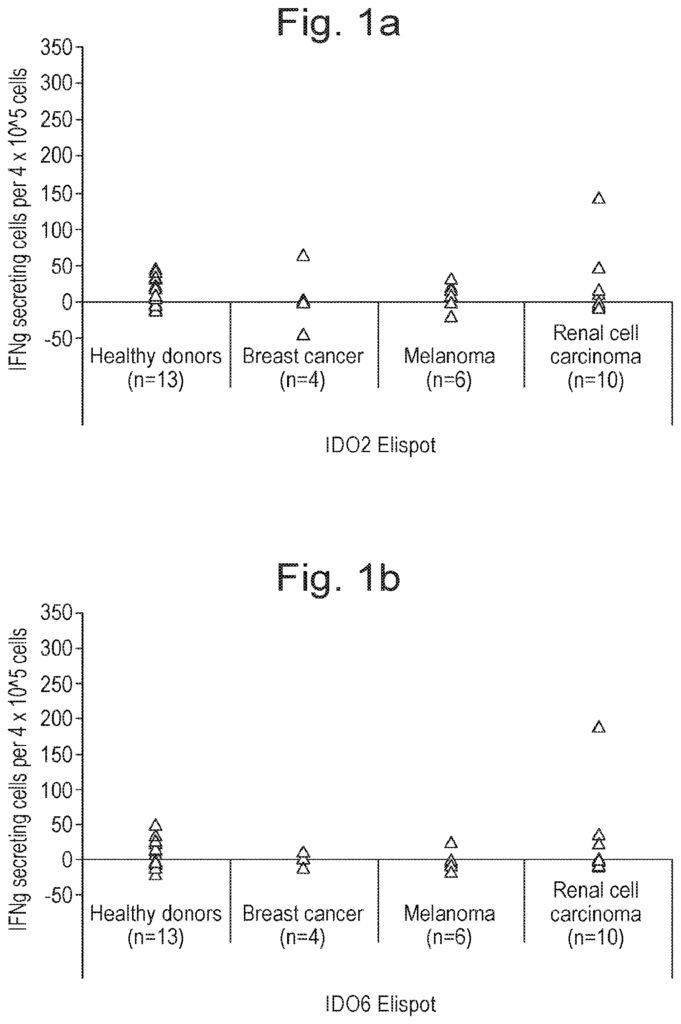
The IO Biotech ApS invention works as follows
The present invention is a prophylaxis or therapy for cancer. The protein Indoleamine 2,3 Dioxygenase or fragments of it are capable of eliciting an anti-cancer immunity response. The invention is a treatment for cancer using IDO, peptides or T-cells specific to IDO. The invention relates thus to an anticancer vaccine that may optionally be used in conjunction with other immunotherapies, and to IDO-specific T-cells adoptedively transferred or in vivo induced by vaccination as treatment for cancer. The invention includes the ability to use the provided medicaments in conjunction with cancer chemotherapy. Another aspect is the treatment and prevention of infection using the same methods as above. “The use of IDO, and immunogenic fragments thereof in cancer and infection diagnosis, treatment and prognosis are also provided.
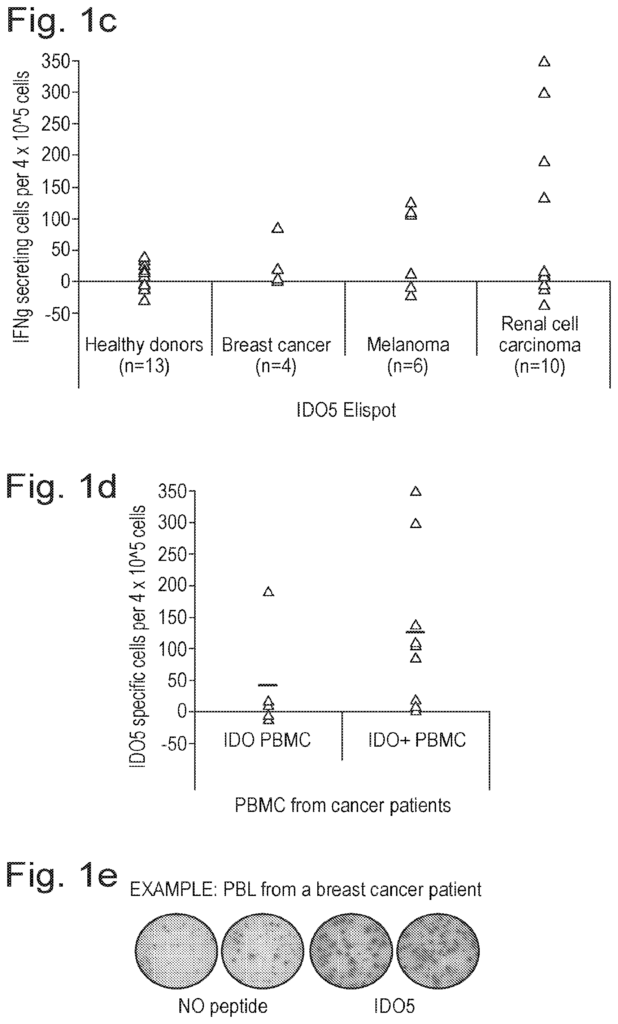
Background for Indoleamine 2,3 dioxygenase-based immunotherapy
The immune response is capable of recognizing and destroying neoplastic cell. However, even though neoplastic change is often associated with immunogenic antigens expressed, the immune response does not always respond to these antigens. Immune system becomes tolerant to these antigens. The neoplastic cancer cells will then proliferate uncontrollably, leading to a poor prognosis. “Cancer immunotherapy will only be successful if the acquired state of toleration is overcome.
Indoleamine 2-, 3-dioxygenase is a key component of maintaining homeostasis in the immune system, which contributes also to tumor-induced intolerance. IDO expression and activation creates a tolerogenic environment in the tumor, and tumor draining lymph nodes. This occurs either by direct suppression of T-cells via degradation of essential amino acid tryptophan, or through enhancement of local immunosuppression mediated by Treg (activated regulatory T-cells). In the case of the former, IDO’s biological effects are partly mediated by local tryptophan depletion, while others are mediated by immunomodulatory tryptophan-metabolites3. Recent research has identified a T-cell signaling system that is IDO responsive. It consists of the stress kinase GCN2. GCN2 responds when uncharged tRNA levels are elevated, which would be the case if a T cell was deprived of tryptophan. T cells without GCN2 will not respond to IDO-mediated inhibition and anergy.
IDO is expressed by both tumor cells and tumor stromal cell in the tumor, where it inhibits immune response effector phase. IDO-expressing APCs are also present in lymph nodes draining tumors, where it is believed that they create a tolerogenic environment. IDO-expressing CD19+ dendritic (DC) cells isolated from tumor draining lymph nodes mediate profound immunosuppression and T cell anergy, in vivo7. Plasmacytoid DCs from normal lymphoid tissue and the spleen, however, do not express IDO. IDO is constitutively expressed by very few lymphoid cells in normal tissue, except for the gut. This means that DCs within tumor-draining nodes must be stimulated by a tumor. This stimuli is thought to be delivered from activated regulatory T-cells (Tregs), migrating to the draining node. It has been demonstrated that Tregs induce IDO through the cell-surface expression CTLA-49. Induction of IDO transforms lymph nodes draining tumors from immunizing to a tolerizing environment. In fact, when IDO+DCs are injected into lymph nodes draining injection sites, they suppress and anergize antigen-specific cells. IDO can be found in the tumor microenvironment in both the tumor cells and stromal cells. IDO may inhibit the effector phase in this situation11,12. In the clinic, expression of IDO on tumor cells has been associated with a poor prognosis13.
The expression of IDO, and the IDO-induced immunosuppression of cancer that occurs in conjunction with it, poses a serious problem for the treatment of cancer.
The present invention solves the problem of cancer immunosuppression. It is based on a surprising discovery by the inventors that spontaneous cytotoxic immunity responses are triggered against IDO-expressing cells in patients with cancer. These findings may lead to novel diagnostic and therapeutic approaches that can be used in the treatment of cancer.
The present invention is designed to target cancer by directly killing cancer cells that express IDO and by killing APCs/DCs that express IDO, thereby causing anergy. The T cells are enabled to recognize IDO-expressing cells. When the clinical condition is infection, T-cells are enabled to kill APCs/DCs expressing IDO. The application of this method, which targets IDO-expressing cells, is beneficial in combination with the expression of IDO, an immune suppressing enzyme, in cancer cells and in APCs. This approach, particularly as it involves the killing of APCs/DCs goes against the general opinion in the field. IDO is generally down-regulated/inhibited to remove the tolerizing environment around the APCs/DCs and preserve these cells which are considered necessary to launch an efficient immune response.
Furthermore the discovery of spontaneous cytotoxic immunity against IDO-expressing cells is especially surprising, since IDO-expressing cells can counteract the desired effects from other immunotherapeutic methods.” Combining IDO- and cancer-targeting immune therapies is highly synergistic.
The present invention relates to a vaccine composition containing Indoleamine 2,3 Dioxygenase, (IDO), of SEQID NO: (11, 13, 14, 15, and/or 16,) or a functional orthologue thereof, having at least 70% similarity to SEQID NO: (11, 13, 14, 15, and/or16), or an immunogenically-active peptide, comprising a sequence of said IDO, or said functional heterologue thereof, or a nucleic acids encoding said
The aspect of the invention that concerns a kit of parts containing the vaccine composition and another immunostimulating component provides for the synergistic effects of a combination immunotherapies on the basis of the vaccine disclosed above.
The aspect of combining cancer treatments, such as chemotherapy agents, with the vaccine of this invention is also described here.
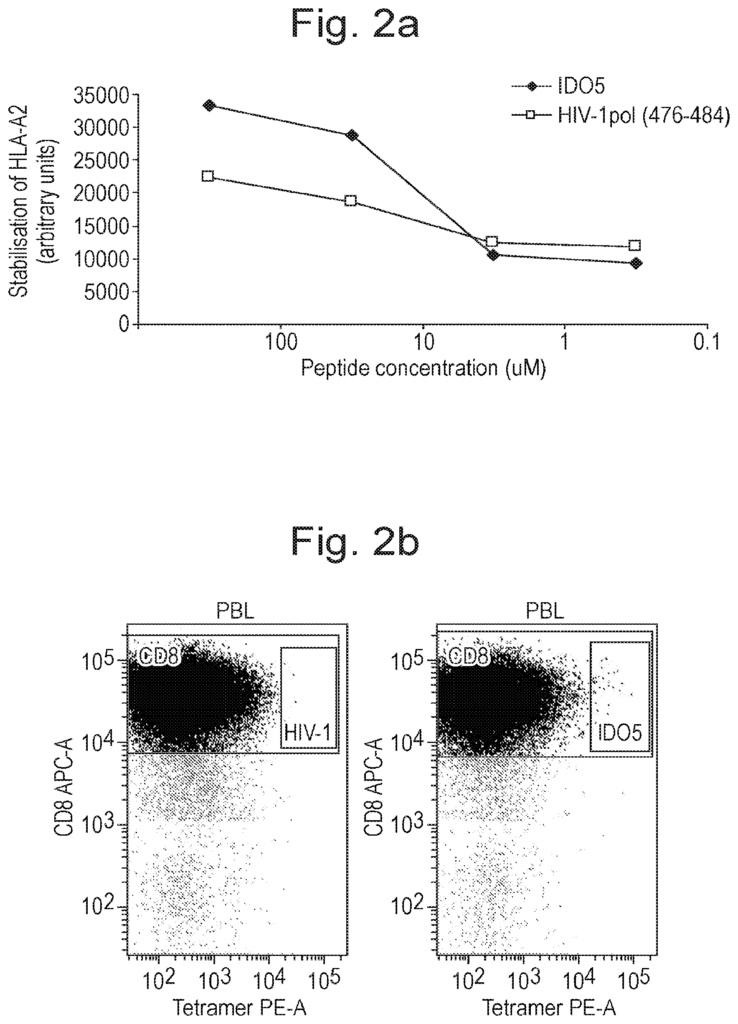
The aspect of combining immunotherapies or antibiotics with the vaccine of this invention is also described here.
Another aspect of the invention relates to a diagnostic kit for ex-vivo or in-situ diagnosis of the presence of T cells that are reactive with IDO in a patient’s tumor tissue or PBL. The kit comprises Indoleamine 2,3 dioxygenase, or its functional homologue, having at least 70% similarity to SEQ ID No (1, 13, 14 and/or 15), or an immunogenically effective peptide fragment containing a sequence of said IDO. Another aspect relates to a diagnostic kit that can be used for in situ or ex vivo diagnosis of T cells reactive with IDO in PBLs or tumor tissues in cancer patients. The kit contains Indoleamine 2,3 dioxygenase, or its functional homologue, which has at least 70% similarity to SEQ ID No (1,13,14,15 and/or16) or its functional homologue.
The present invention also provides for a complex consisting of a peptide containing a sequence of the IDO or its functional homologue and either a Class I or Class II HLA molecule, or a fragment thereof.
A further aspect of this invention is “A method for detecting the presence of IDO-reactive T-cells in cancer patients, which comprises contacting tumor tissue or blood samples with a complex consisting of a peptide containing a sequence of IDO or its functional homologue and a class I or II HLA molecule molecule or fragment thereof and detecting the binding of the complex on the tissue or blood cells.
Yet another aspect of the invention relates to a specific molecule capable of binding to a fragment of peptide containing a sequence consisting of said IDO, or its functional homologue.
The present invention includes a method for treating a disease such as cancer or infection using any of the above-described means. This may include administering an effective dose of the vaccine composition to a patient suffering from this condition; a molecule capable of binding to a sequence of peptides that contains the IDO or its functional homologue; or a kit of parts that comprises the aforementioned molecule or vaccine in combination with another immunostimulating agent and/or chemotherapy.
It is also the object of this invention to use a immunogenically-active peptide fragment containing a sequence of the IDO or its functional homologue or the vaccine composition above, in the manufacturing of a drug for the prevention or treatment of cancer.
Another object of the invention is a monitoring method for immunization. This method comprises the following steps: providing a sample of blood from an individual, providing an IDO of SEQID NO: (11, 13, 14, 15, and/or 16,) or functional homologue of IDO having at least 70% similarity to SEQID NO: (11, 13, 14, 15, and/or16), or an immunogenically-active peptide containing a sequence of IDO, functional homologue of IDO, or nucleic acid or a peptide or a peptide or a peptide or a peptide or a peptide or a peptida peptide or peptide or peptide or peptide peptide or a peptide peptide peptide or a peptide peptide peptide or a peptide or the peptide or the peptide peptide peptide peptide a peptide encoding a sequentially-active peptide-active peptide-based immunogenically-active peptide-based immunogenically-active peptide-based peptide-based peptide-based peptide-based peptide-based peptide-based peptide-like peptide-based peptide-based a a a a a a -based peptide- – –
BRIEF DESCRIPTION DES DRAWINGS
FIG. FIG. After T lymphocytes have been stimulated with peptide VLSKGDGL (SEQ ID No: 7), ELISPOT was used to measure the response. 1 a.
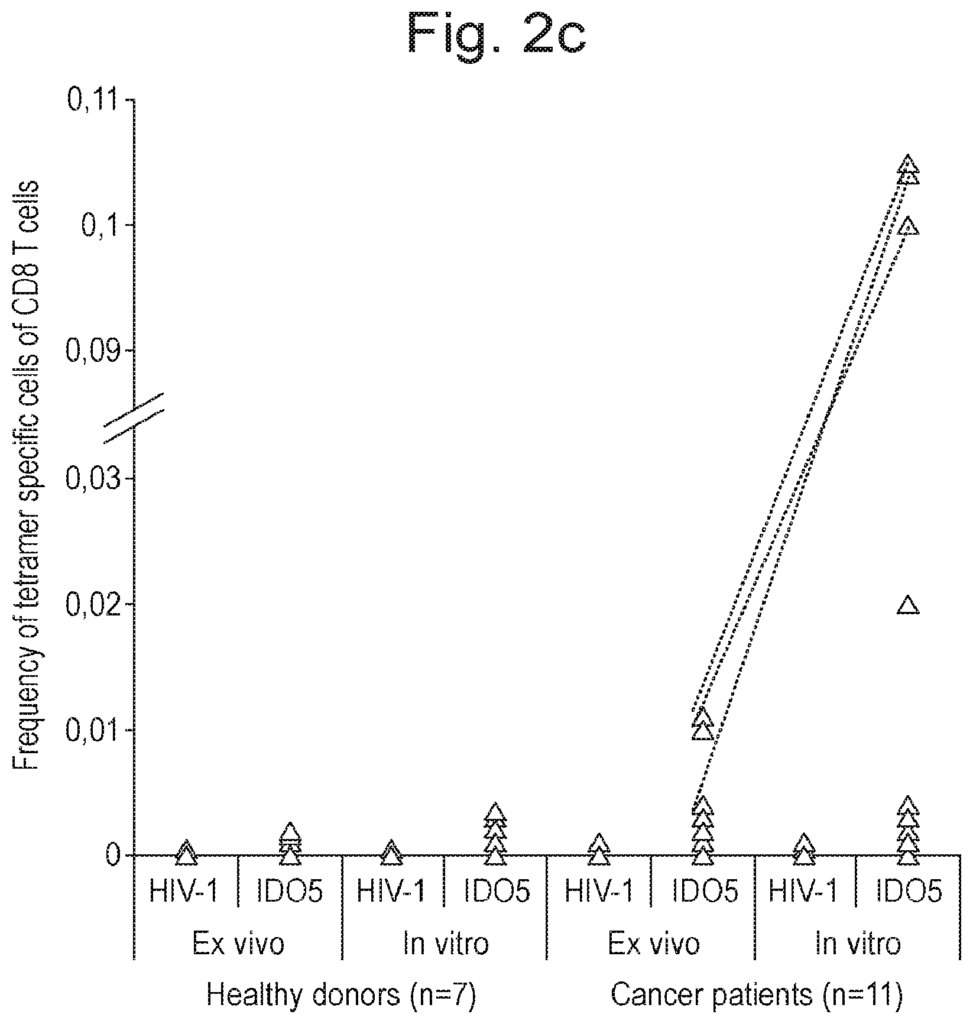
Click here to view the patent on Google Patents.
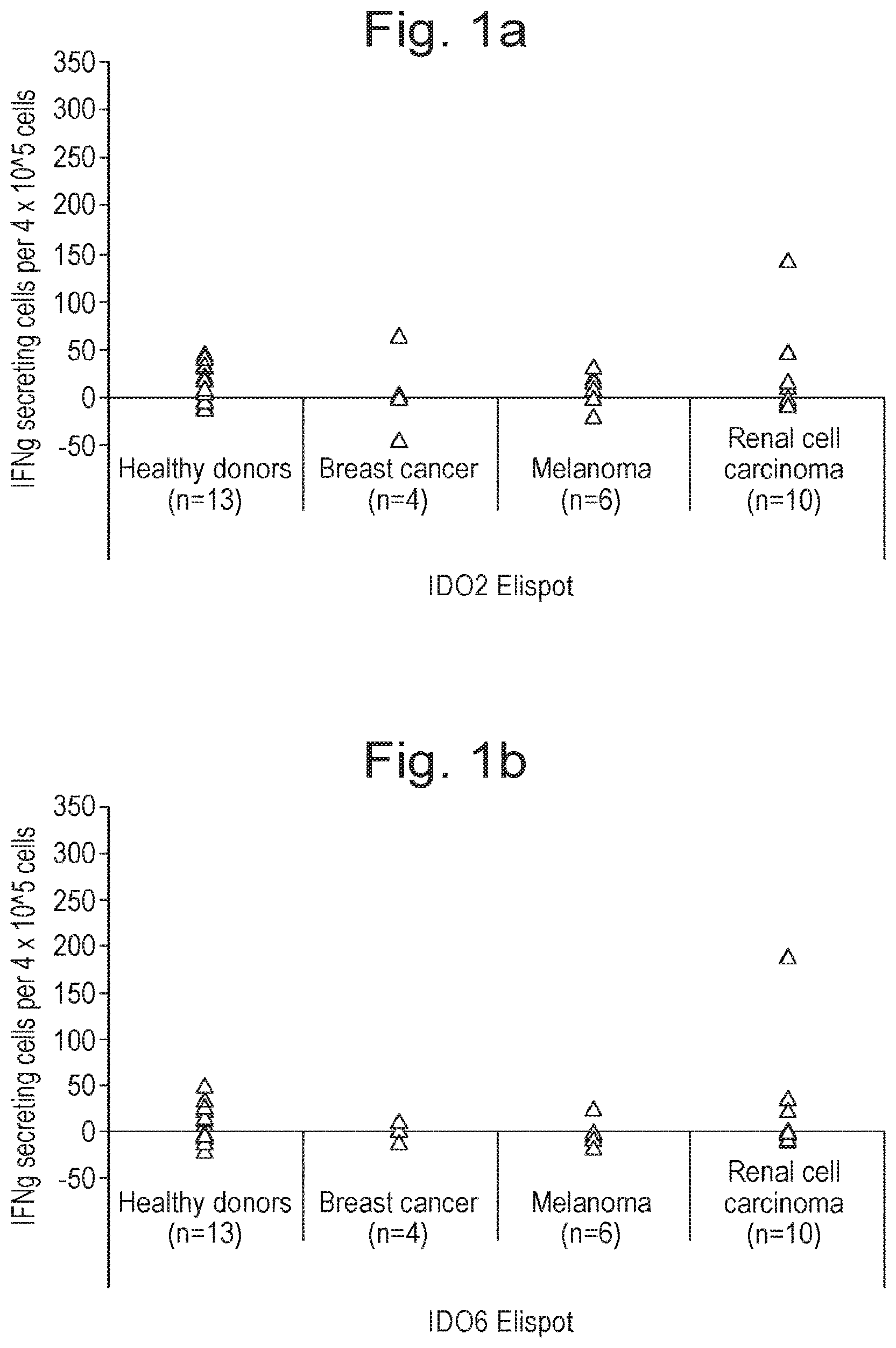
Leave a Reply